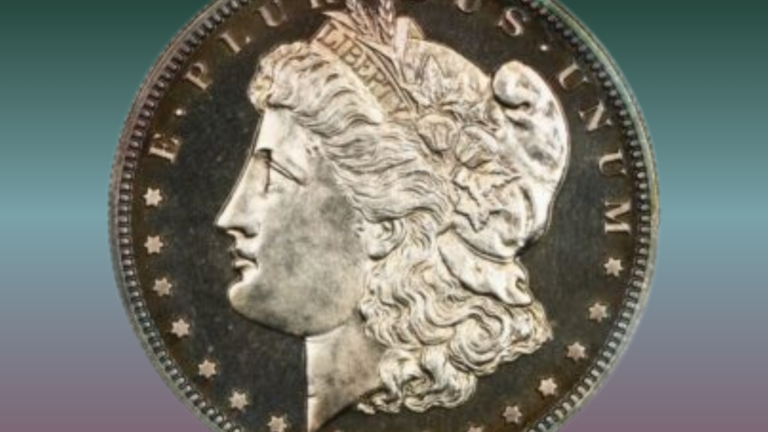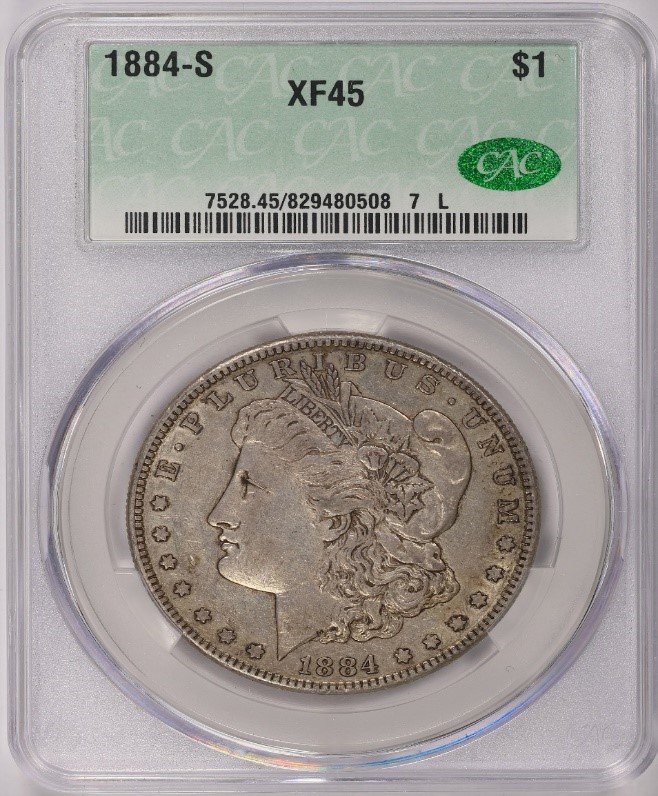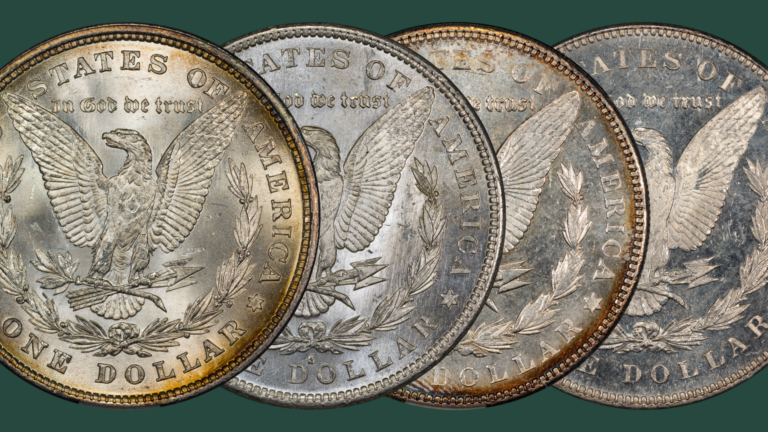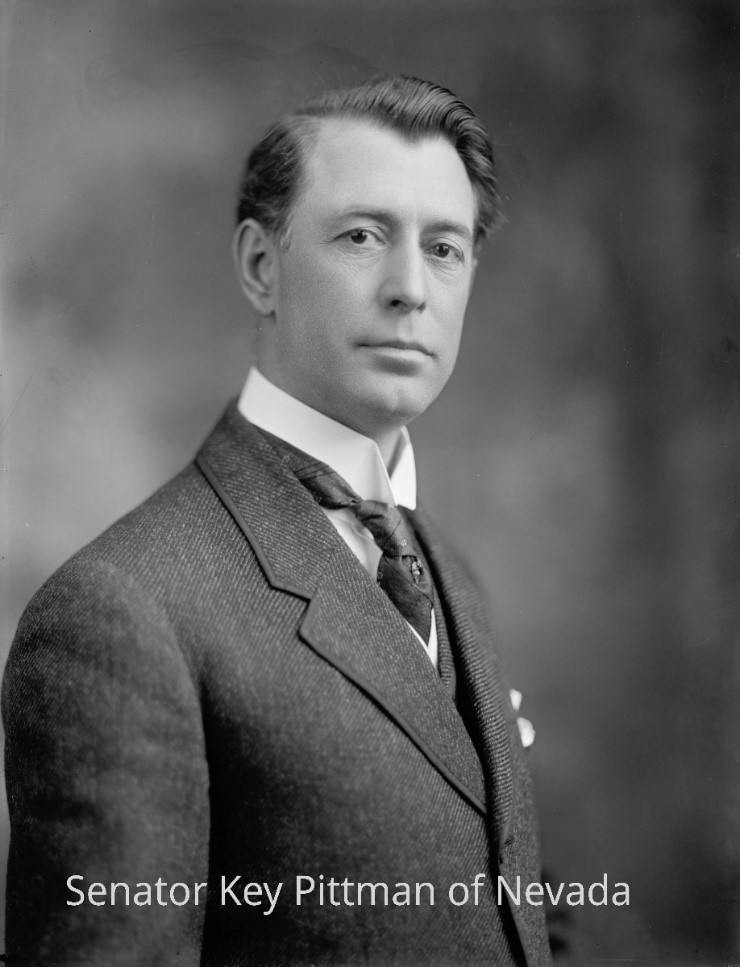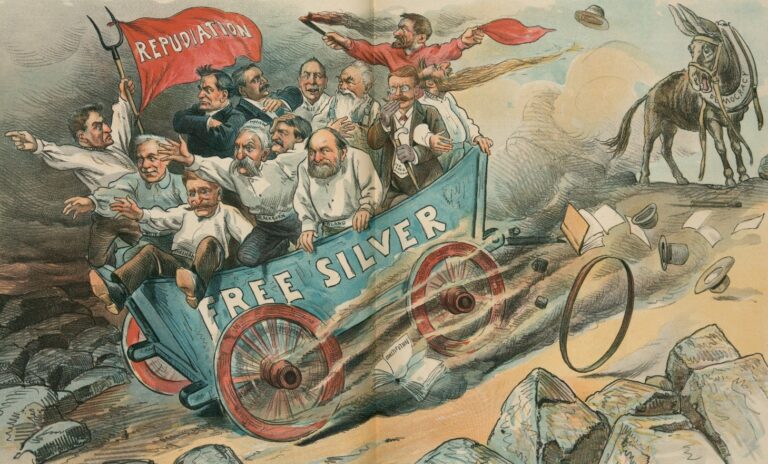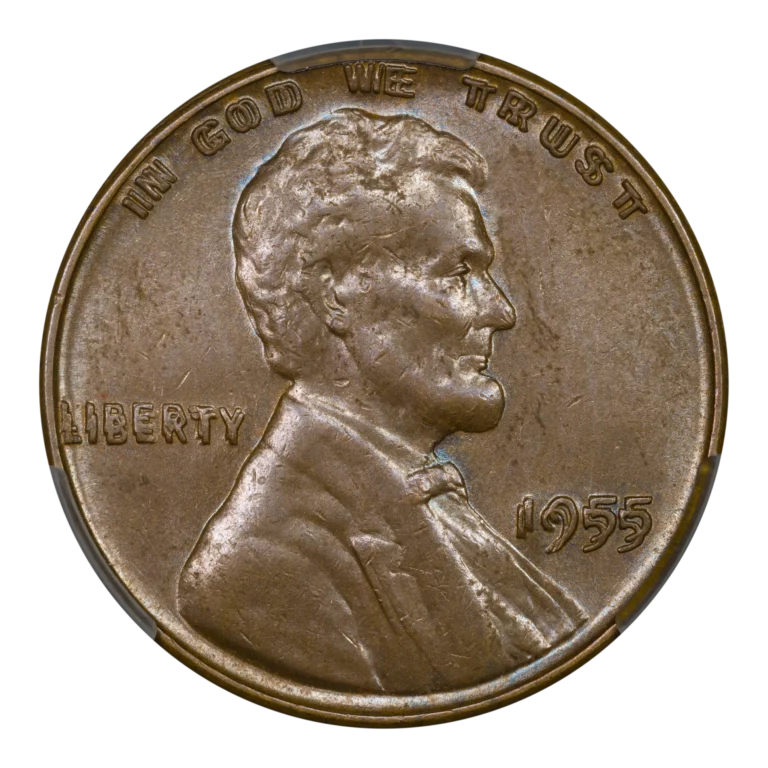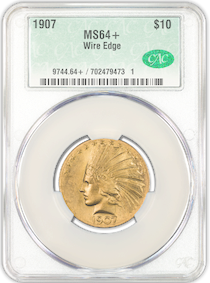by Greg Reynolds
Barber quarters were minted from 1892 to 1916. This discussion follows my introduction to collecting Barber quarters ‘by date’ (and mint location) in MS-64 to MS-65 grades. That discussion was aimed at beginners and was mostly about MS-64 and MS-65 Barber quarters of the least scarce dates, which are sometimes called “common dates” by others. In MS-64 and higher grades, there are ‘no common date’ Barber quarters, though some are much less scarce than others.
The keys are the scarcest dates in the series overall, and much has been written about key date Barber quarters. The emphasis here is on semi-keys and dates that are not semi-keys though are very scarce in MS-64 and higher grades.
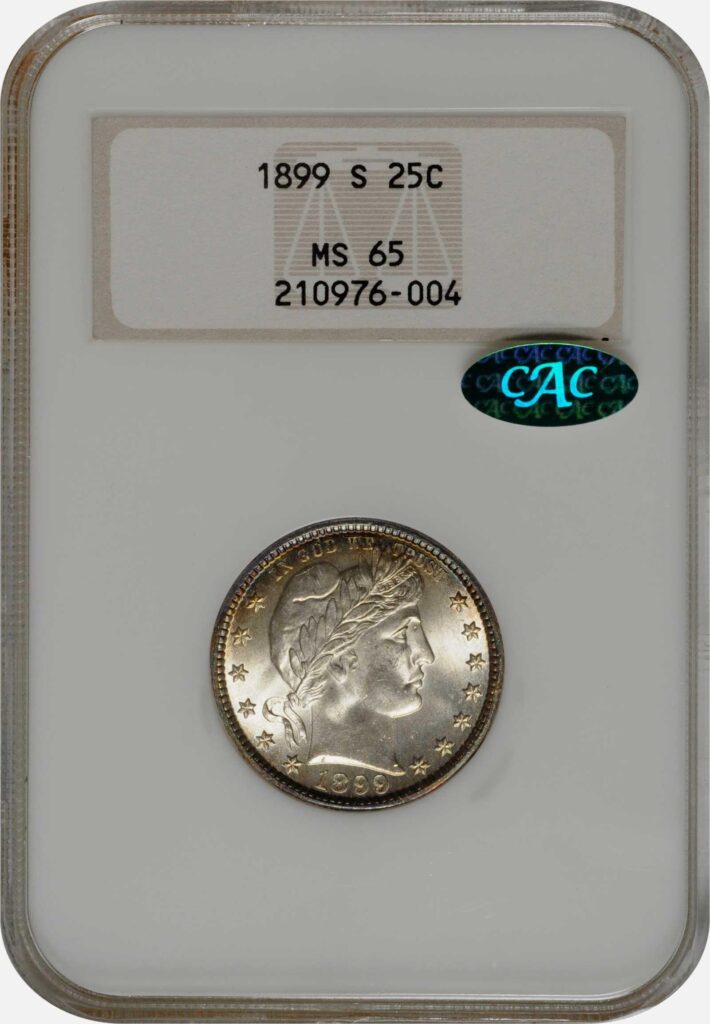
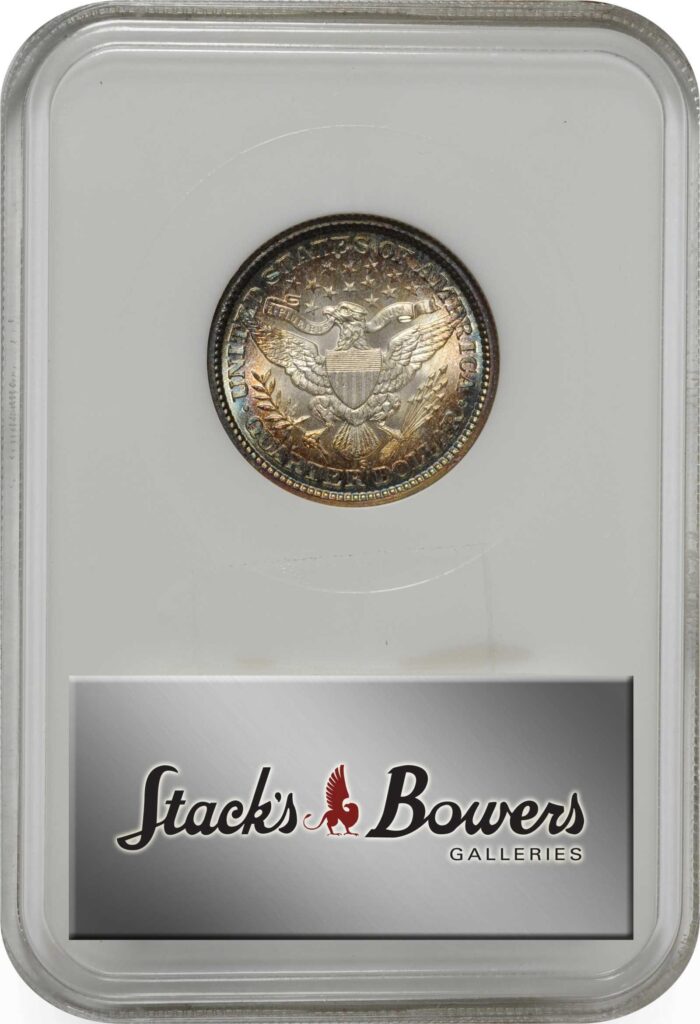
The keys are the 1896-S, the 1901-S and the 1913-S. The nature of keys to a series relates to the number of coins that survive in all grades. Even Good-04 grade 1896-S, 1901-S and 1913-S quarters are certainly scarce and relatively expensive.
Semi-keys are not as scarce as the keys, and are in the next tier below. For many series of classic U.S. coins, a semi-key may be much less expensive than a key. Additionally, some Barber quarters are condition rarities in uncirculated (‘MS’) grades and not particularly scarce in lower grades.
The definite semi-keys in the series of Barber quarters are all relatively very scarce in circulated and uncirculated grades: the 1896-O, the 1901-O, the 1909-O and the 1914-S. There are additional dates that are arguably semi-keys and/or are condition rarities in MS-64 to -66 grades.
The CPG medium retail estimate for a VG-08 grade 1895-O, a better date, is $21, while the estimate for a VG-08 grade 1896-O, a semi-key, is $130, more than six times as much, as of December 2024. In MS-64 grade, the corresponding CPG-CAC medium retail estimates are $1600 for the 1895-O and $4500 for the 1896-O. This is an illustration of the point that keys and semi-keys are not just condition rarities above a particular grade-level, they are relatively very scarce overall, throughout the spectrum of grades from 01 to 69.
The 1896-O is often overshadowed by the 1896-S. In grades below VF-20, 1896-O quarters are generally available and 1896-S quarters are far rarer. In MS-63 and MS-64 grades, the total CAC population of each is two. In MS-65, the population of each is four, though CACG has graded one 1896-O as MS-65+. In MS-66, the CAC population of the 1896-O is two, while the population of the 1896-S is zero. In May 2023, the firm of Gerry Fortin sold a CAC approved MS-65 grade 1896-O for $7000.
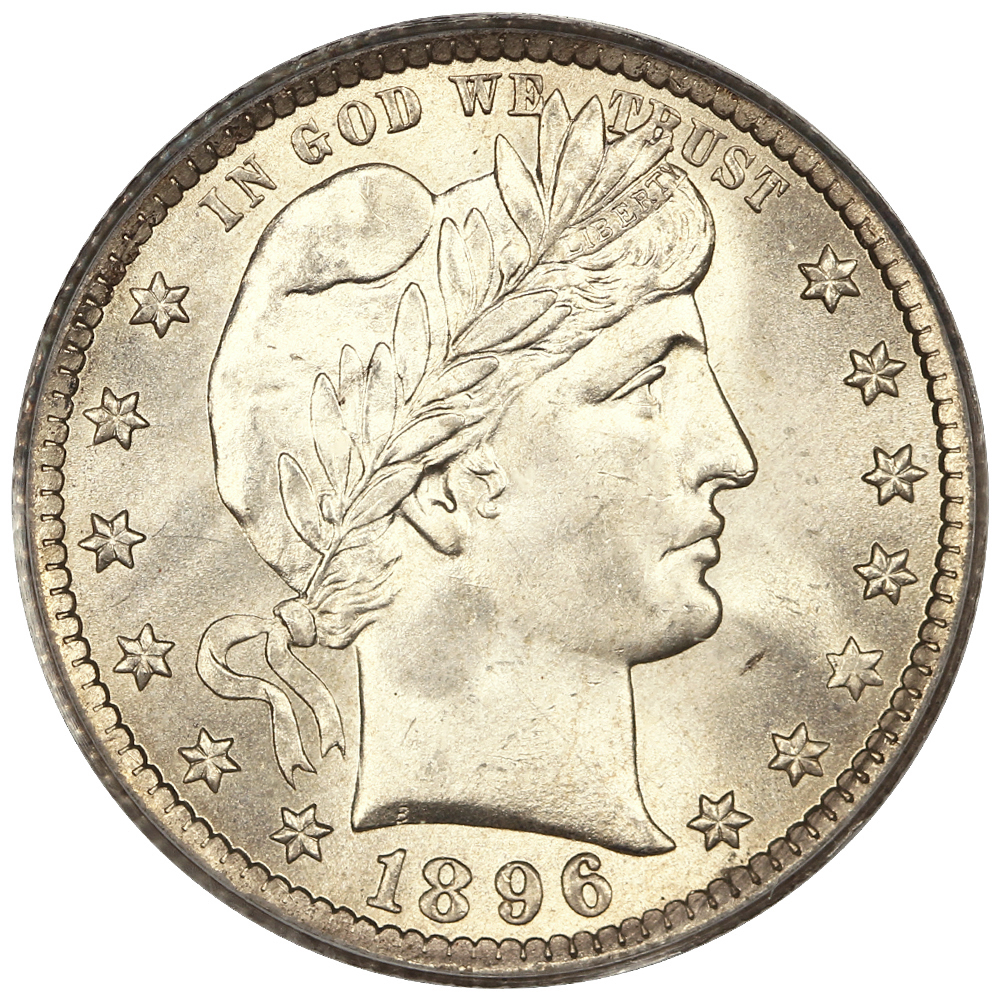
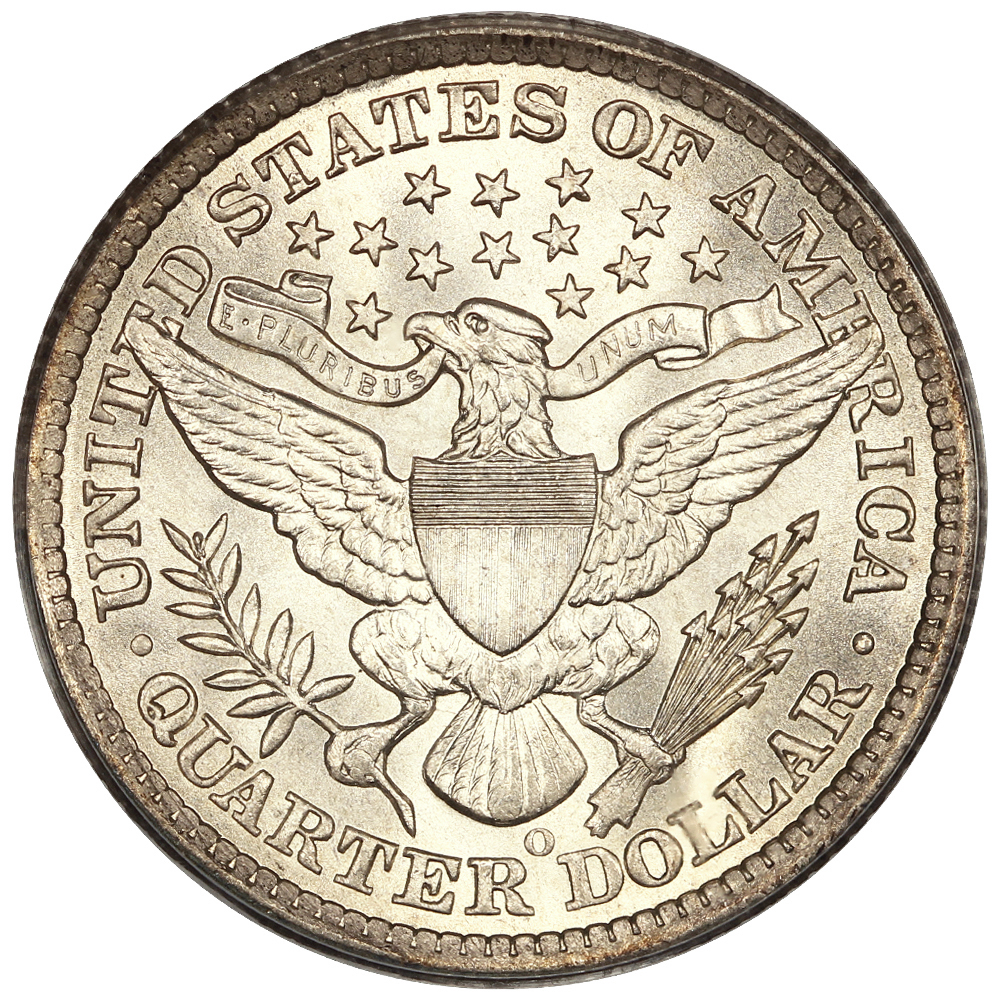
On Oct. 15, 2023, DLRC sold a CAC approved MS-65 grade 1896-O for $7109, in range of the December 2024 CPG-CAC medium retail price estimate of $7500. In their book, The Complete Guide to Certified Barber Coinage (Virginia Beach: DLRC Press, 1999, p. 50), David & John Feigenbaum stated that the 1896-O is the eighth scarcest Barber quarter in uncirculated (“Mint State”) grades and has the twenty-third lowest mintage. The overall position of the 1896-O, with consideration of scarcity in all grades, circulated and uncirculated, may very well be higher than eighth.
The 1897-O & The 1897-S
Though not semi-keys, the 1897-O and the 1897-S are CAC rarities in uncirculated grades. The CAC population of the 1897-O in MS-64 is six and the CPG-CAC medium retail estimate is $3900. The CAC pop in MS-65, however, is merely one. The CAC pop of 1897-O quarters in MS-66 is seven.
In MS-64 grade, the CAC population of the 1897-S is just four and the CPG-CAC estimate is $5250. In MS-65, CAC has stickered three PCGS or NGC graded 1897-S quarters in the MS-65 range, and CACG has encapsulated one, for a total of four. Curiously, the CAC total pop in the MS-65 and higher range is the same for the 1897-O and the 1897-S, nine of each. There is an excellent chance that a collector who has some patience and is not too eager will be able to buy MS-64 to -66 grade 1897-O and 1897-S quarters for reasonable enough prices, perhaps less than CPG-CAC retail estimates.
The 1897-O, the 1897-S and the 1898-O are similar in condition rarity above MS-63. In MS-64 to -65 grades, the CAC population is eight for the 1897-S and also eight for the 1898-O, as of December 1, 2024. Overall, however, the 1897-S is much scarcer than the 1898-O. They are both condition rarities in grades above MS-63, yet most collectors care about total populations, not just populations above MS-63. There is no magic formula that explains market prices of condition rarities.
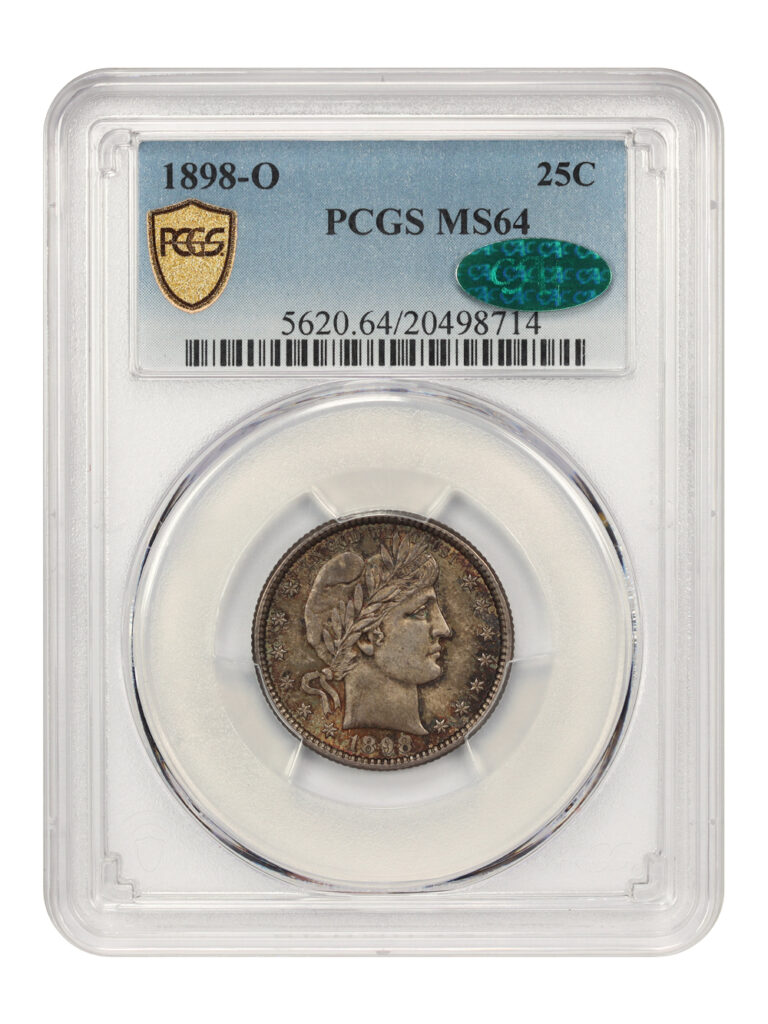
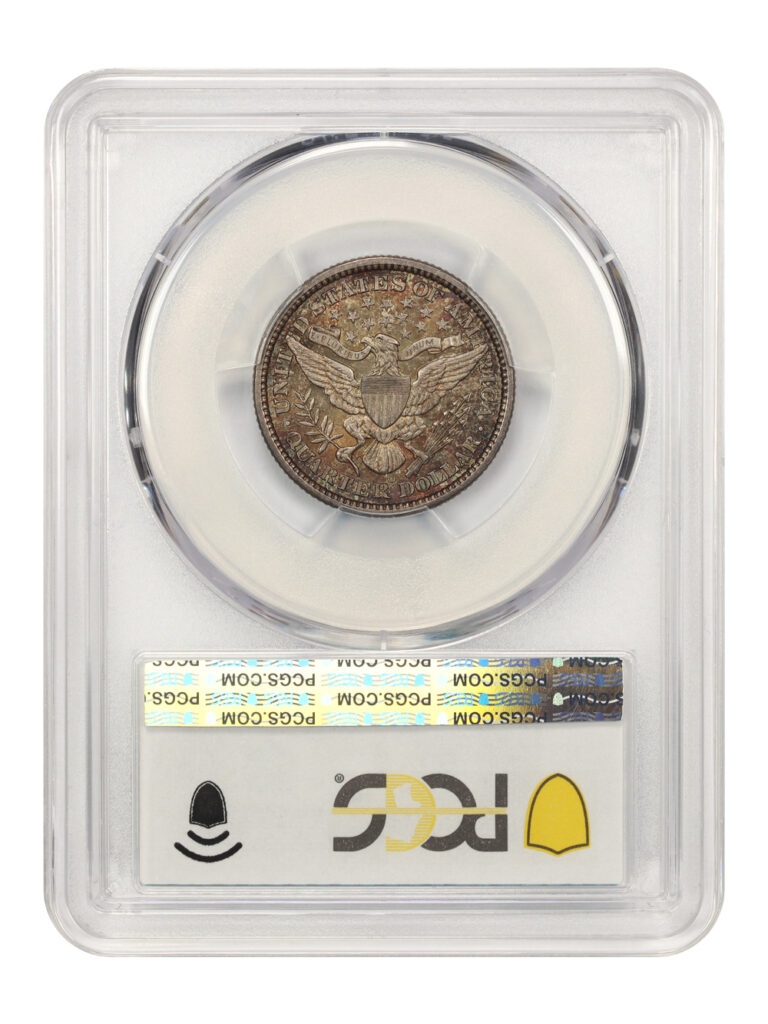
On Feb. 22, 2024, DLRC sold a CAC approved MS-64 grade 1898-O for $2450. On Oct. 15, 2023, DLRC sold a CAC approved MS-65 grade 1898-S for $7200.
The 1898-S & The 1899-S
The 1898-S is definitely a condition rarity in grades above MS-64. Overall, however, the 1899-S is scarcer than the 1898-S. The 1898-S and the 1899-S are not all that scarce in grades below MS-64 and somewhat easy to find in grades below Fine-15. On June 22, 2017, Stack’s Bowers auctioned a CAC approved MS-64 grade 1898-S quarter for $4582.50. In 2017 or 2024, this was a strong to very strong price, yet it might not be practical to buy one for less than $4000.
In their already cited book that was published in 1999, David & John Feigenbaum announced that the “1898-S is our new favorite date of this series. This date comes with a very sharp strike,” and they added that the key 1901-S is only slightly rarer in uncirculated grades.
In December 2024, the CAC pop in MS-64 to -67 grades is seven for the 1898-S and six for the 1901-S. In VF-20 grade, however, an 1898-S is worth around $100 while a 1901-S would be likely to retail for more than $20,000. Nonetheless, the point made by the Feigenbaums regarding the comparative rarity of the 1898-S and the 1901-S in uncirculated grades is interesting and thought provoking.
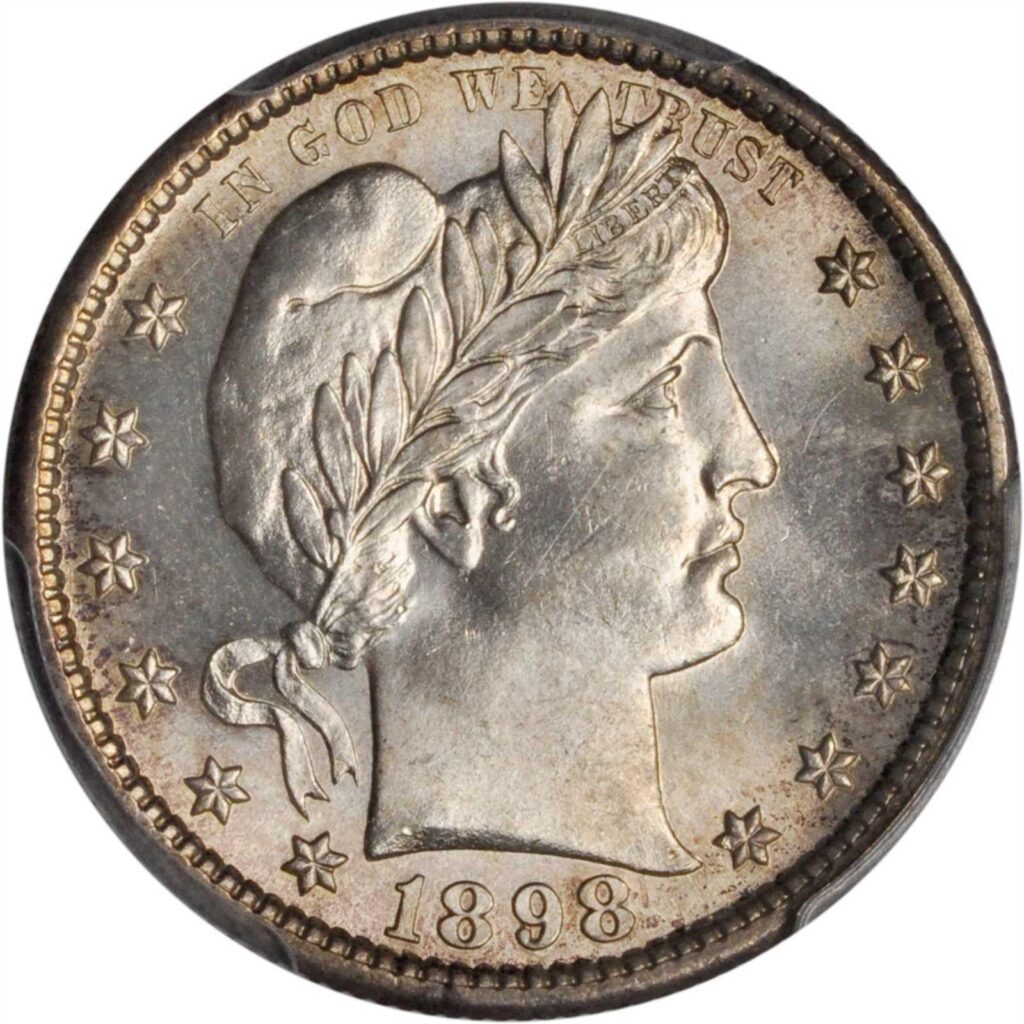
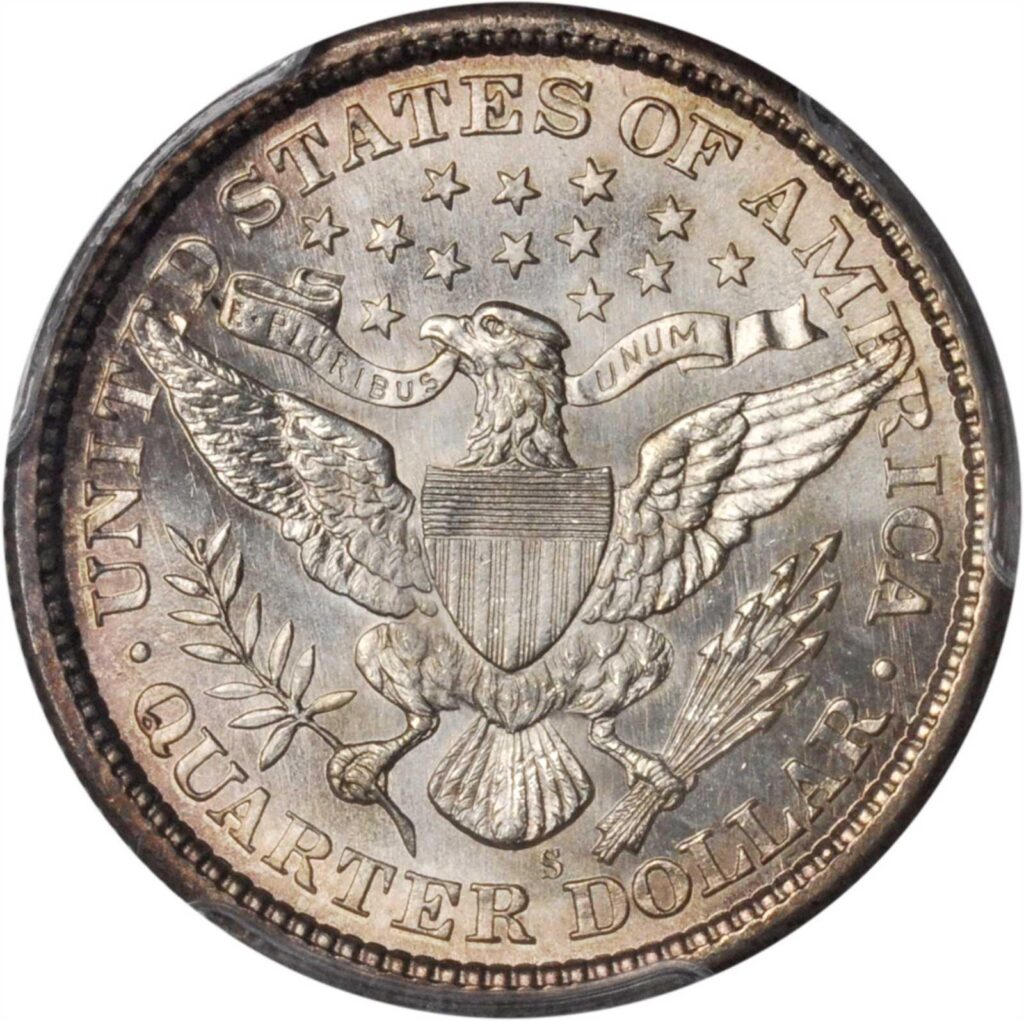
The 1899-S must be considered in the same context as the 1898-S. It is almost as rare in MS-64 to MS-66 grades, and is much scarcer in circulated grades than the 1898-S. It could be reasonably argued that the 1899-S is closer to being a semi-key than the 1898-S. On Dec. 17, 2020, Stack’s Bowers sold a CAC approved, NGC graded MS-64 1899-S quarter for $4920. As of Dec. 1, 2024, the CPG-CAC medium retail estimate for a MS-65 1899-S, with a CAC sticker, was $5750. The corresponding estimate for a CAC approved MS-64 1899-S was $3900, even though the population is zero in MS-64 grade. While 1899-S quarters are not that scarce in circulated grades, they are extremely scarce in uncirculated grades and are CAC rarities in all ‘MS’ grades.

Show off Your Collection in the CAC Registry!
Have CAC coins of your own? If so, check out the CAC Registry–the free online platform to track your coin inventory, showcase your coins by building public sets, and compete with like-minded collectors!
The 1900-S
As is true of many dates in the series, the 1900-S is relatively common in circulated grades, yet is very scarce in uncirculated grades. On Nov. 3, 2024, DLRC sold a CAC approved MS-64 grade 1900-S quarter for $3699. Was there another recent public sale of a CAC approved MS-64 to -65 grade 1900-S quarter?
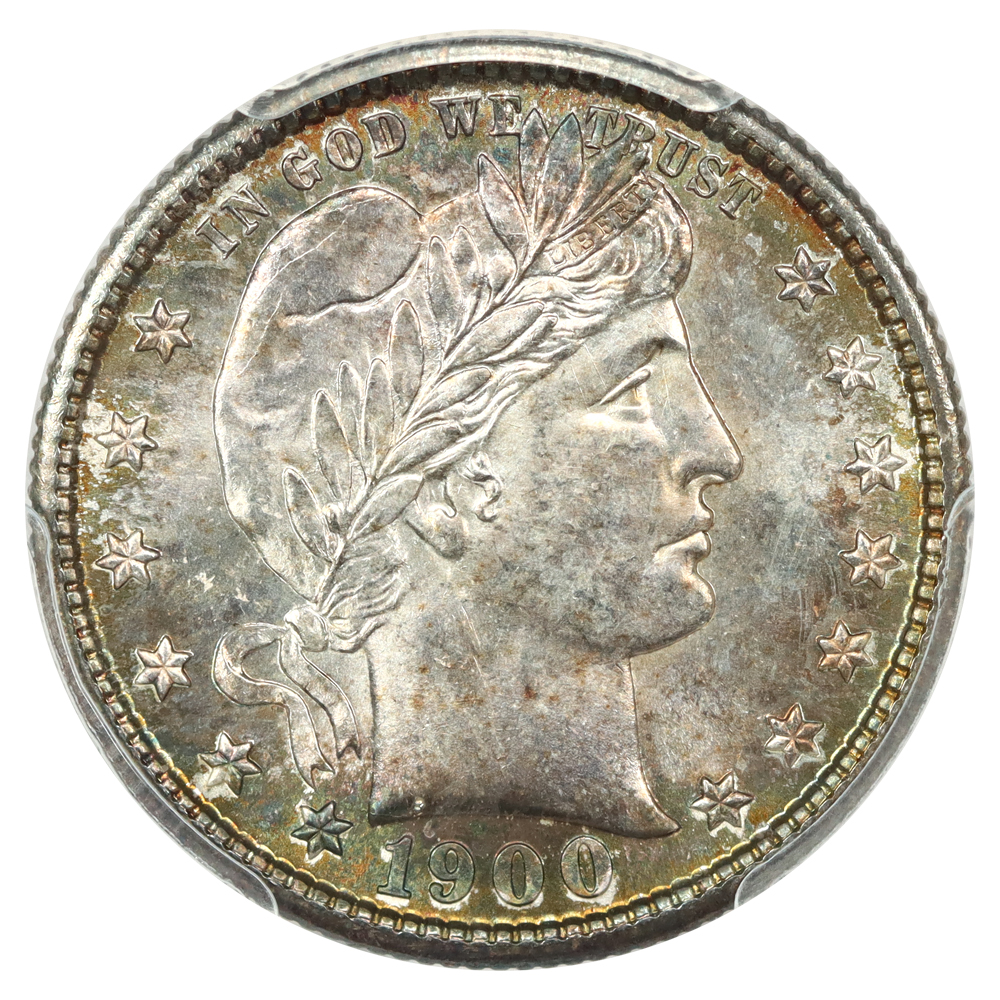
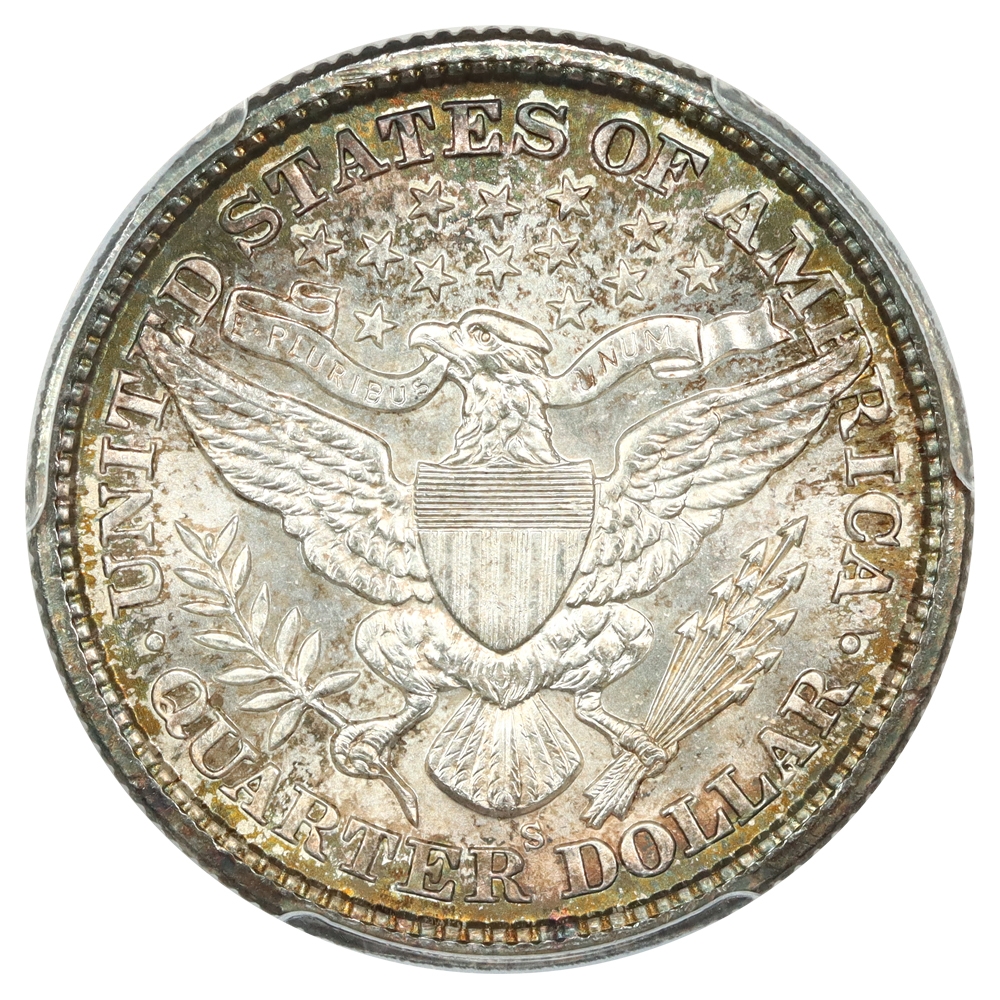
As of Dec. 1, 2024, CAC reports zero 1900-S quarters in the MS-60 to -63 range, one as MS-64, zero as MS-65, three as MS-66, one as MS-67, and zero higher. PCGS reports ten as MS-65 or -65+ and the NGC census of 1900-S quarters in the MS-65 range is three.
Someone assembling a CAC-only set may consider downgrading a few Barber quarters, possibly including a 1900-S. In a situation where a dealer is selling a non-CAC MS-65 grade 1900-S, the buyer could ask the seller for a money back guarantee that it will grade at least MS-64 at CACG in Virginia Beach. Although the seller could say ‘no,’ it may make sense for someone working on a CAC-only set to ask.
The 1901-O is a semi-key, which receives little attention because the 1901-S is the most famous date in the series. On Sept. 18, 2022, the firm of David Lawrence (DLRC) sold a CAC approved, MS-64 grade 1901-O for $4210.
The 1907-S & The 1908-S
The 1907-S and the 1908-S invite discussion. Although they are not quite semi-keys, they are much better dates and are CAC rarities in grades above MS-63. The 1907-S especially is an extreme CAC rarity in this range with a CAC population of zero in MS-63, three in MS-64, zero in MS-65 and four in MS-66.

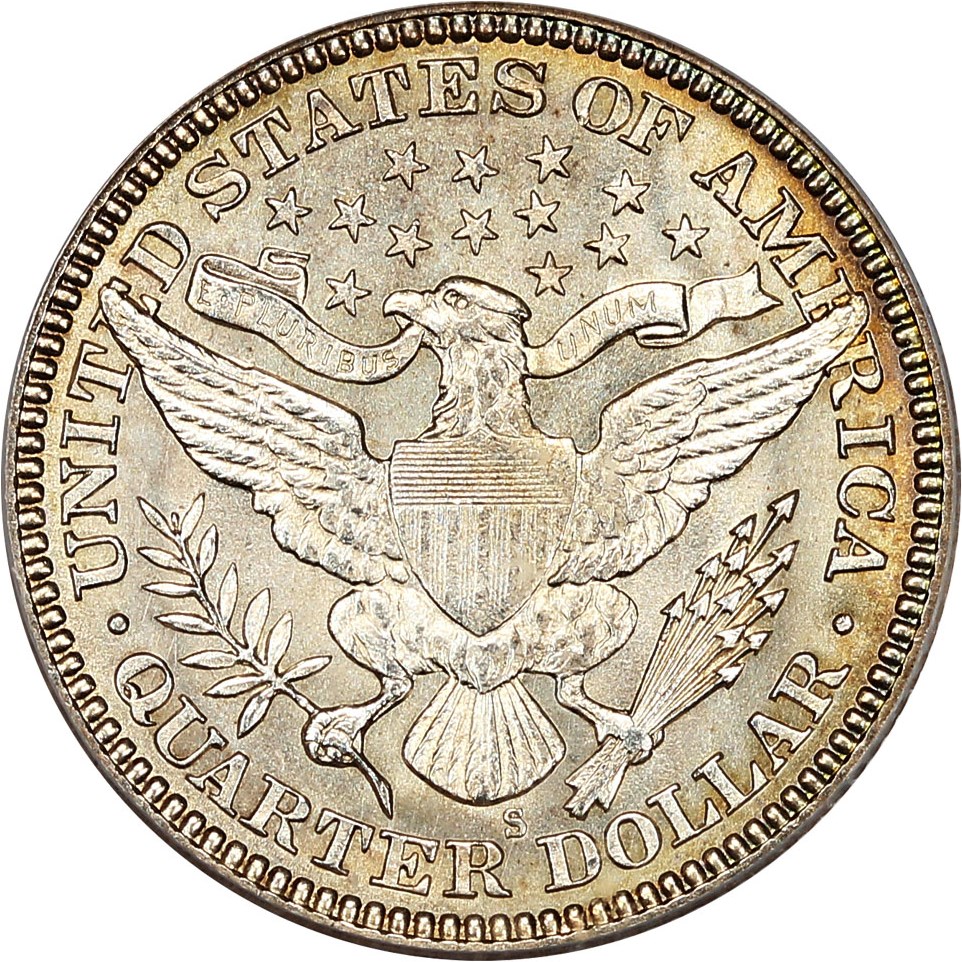
In 2019, DLRC sold two CAC approved MS-64 grade 1907-S quarters, for $2850 on June 2, and for $2000 on Nov. 17. It is likely that both of these would sell for considerably more if DLRC or one of the big three auction houses sold them in 2025.
In July 2019, the firm of Gerry Fortin sold a CAC approved MS-64 grade 1908-S for $1825. As of Dec. 12, 2024, the current CPG-CAC retail estimate for a MS-64 grade 1908-S is $2850, yet it was $1875 from Nov. 28, 2023 to June 26, 2024. The reasons for the recent increase to $2850 are unclear to me. Could a more applicable medium retail estimate be $2250?
On March 22, 2018, Stack’s Bowers auctioned a CAC approved MS-65 grade 1908-S for $3600. As of Dec. 11, 2024, the current CPG-CAC retail estimate is $4500.

The Curious Case of the 1911-D
Indisputably, the 1909-O is a semi-key and is rather famous as such. Much has already been said about it. The 1911-D, however, is largely unrecognized.
Although it would not be accurate to refer to the 1911-D as a semi-key, it is curiously elusive in uncirculated grades. I theorize that the PCGS population of twenty-five 1911-D quarters in MS-64 and the NGC census of sixteen both include multiple resubmissions of some of the same individual coins. Indeed, the CAC population of the 1911-D in MS-64 is one.
Both PCGS and NGC have certified just a very small number of 1911-D quarters in grades above MS-64. The 1911-D is an extreme CAC rarity in this range. The CAC pop in MS-65 is zero and is also zero in MS-66. One 1911-D has been CAC approved as grading MS-67, as of December 2024.
If a collector cannot find a CAC approved MS-64 or higher grade 1911-D quarter or cannot purchase one for a price that is comforting, then acquiring a lower grade 1911-D might be an option to consider. On April 25, 2021, Heritage sold a CAC approved MS-62 grade 1911-D for $840.
In a book that was published around eight years before CAC was founded in 2007, David & John Feigenbaum wrote that the “1911-D has virtually identical mint state pop as the 1909-O” (1999, p. 71). It might be interesting to compare CAC pops in December 2024.
In MS-60 and MS-61, both the 1909-O, a semi-key, and the 1911-D have a CAC pop of zero. In MS-62, the pop of the 1909-O is zero and the CAC pop of the 1911-D is one. The 1909-O has a pop of four in MS-63 while the corresponding 1911-D pop is two. In MS-64, there are two 1909-O quarters and just one 1911-D. The MS-65 CAC pop of the 1909-O, one, sounds small, yet the MS-65 CAC pop of the 1911-D is zero.
In MS-66 grade, a 1909-O quarter is estimated to be worth more than 50% above the value of a 1911-D quarter. The CAC pop in MS-66 of the 1909-O, however, is seven, four with stickers, two that are CACG graded as MS-66 and one 1909-O that is CACG graded as MS-66+. The CAC MS-66 total for the 1911-D is zero. The CAC pop in MS-67 is one for the 1909-O and one for the 1911-D.
In all the years that I have been extremely enthusiastic about Barber coins, I do not recollect anyone raving about 1911-D quarters. Furthermore, no one has ever asked why I did not mention a particular 1911-D quarter in an auction review. I knew collectors who assembled great sets of Barber quarters, including Dr. Duckor, Gene Gardner and the Pogues. Not one of them ever talked to me about a 1911-D. This date has certainly stayed behind the curtains.
Of course, the 1913-S commands much more attention than the 1909-O or the 1911-S. In addition to being a key and being relatively expensive, the 1913-S has the lowest mintage of any Barber quarter.
Even though the 1913-S is one of three keys, the 1913-S is not as much of a condition rarity in grades above MS-63 as several of the dates mentioned here. In all grades, however, the 1913-S is very scarce. On Oct. 9, 2022, GreatCollections sold a CAC approved VF-20 grade 1913-S for $8113.60. The CPG-CAC medium retail estimate for a MS-64 grade 1913-S is $26,500, which I strongly believe is accurate, as of December 12, 2024.
Before purchasing a 1913-S and the other two keys, I suggest acquiring a majority of the dates in the set. Collectors tend to learn while they are collecting. After buying dozens of Barber quarters in MS-64 to -66 grades, a budget-minded collector should think about how much he or she wishes to spend on the keys.
The 1914-S
The 1914-S is not as famous or as scarce as the 1909-O, though the 1914-S is a semi-key, too. It is not widely understood as such.
The fact that the CAC population total for the 1914-S is three times the total for the 1914-D may be disorienting, as the 1914-S is much scarcer in all grades below MS-66. For example, CAC has approved ten 1914-D quarters as grading in the MS-65 range and just one 1914-S quarter as MS-65. The 1914-D is one of the least scarce dates.
In MS-64, the CAC pop is eighteen 1914-D quarters and just four 1914-S quarters. A CAC approved MS-64 grade 1914-S is estimated to be worth nearly ten times as much as a MS-64 grade 1914-D, $4500 vs. $455.
In AU grades, a 1914-S is often worth eight to eleven times as much as an equivalent 1914-D. Generally, after considering grading fees, insurance, shipping costs and time, it is more cost effective to submit circulated 1914-S quarters than equivalent 1914-D quarters to grading services. There are many 1914-D quarters that were never certified or were only submitted once to a grading service of any sort. As a VF-20 grade 1914-D is estimated to retail for $35 and a VF-20 grade 1914-S is estimated to retail for $750, it is unsurprising that more Very Fine 1914-S quarters were submitted for grading and encapsulation.
For many years, I had raw 1914-D quarters and dimes. My grandmother triggered my interest in coin collecting when I was about five years old. Earlier in her life, she had pulled Barber coins from change, from receipts at a business where she worked, and from groups of “old coins” received from friends for face value. By chance, she had several 1914-D quarters and 1914-D dimes, which she gave to me. I treasured them for many years, though I sold them while I was in my twenties and had other matters on my mind.
Given the scarcity of 1914-S quarters and price levels for other scarce Barber quarters, market values for 1914-S quarters are reasonable. On Oct. 9, 2022, GreatCollections sold a CAC approved MS-64 grade 1914-S quarter for $4620. On April 10, 2023, Heritage sold a CAC approved MS-65 grade 1914-S quarter for $4920. Semi-keys and some very scarce dates were covered in this discussion. A set of CAC approved Barber quarters in MS-64 to -66 grades is a realistic objective. I suggest proceeding at a moderate pace and carefully inspecting coins. Collectors often fine tune their preferences over time. Also, it may be enjoyable to include some Barber quarters that were in famous collections in the past, like those that were previously owned by Louis Eliasberg, the Norweb family, Gene Gardner or Dell Loy Hansen.
Images are shown courtesy of David Lawrence (DLRC) and Stack’s Bowers Galleries.
Copyright © 2024 Greg Reynolds
About the Author
Greg is a professional numismatist and researcher, having written more than 775 articles published in ten different publications relating to coins, patterns, and medals. He has won awards for analyses, interpretation of rarity, historical research, and critiques. In 2002 and again in 2023, Reynolds was the sole winner of the Numismatic Literary Guild (NLG) award for “Best All-Around Portfolio”.
Greg has carefully examined thousands of truly rare and conditionally rare classic U.S. coins, including a majority of the most famous rarities. He is also an expert in British coins. He is available for private consultations.
Email: Insightful10@gmail.com

